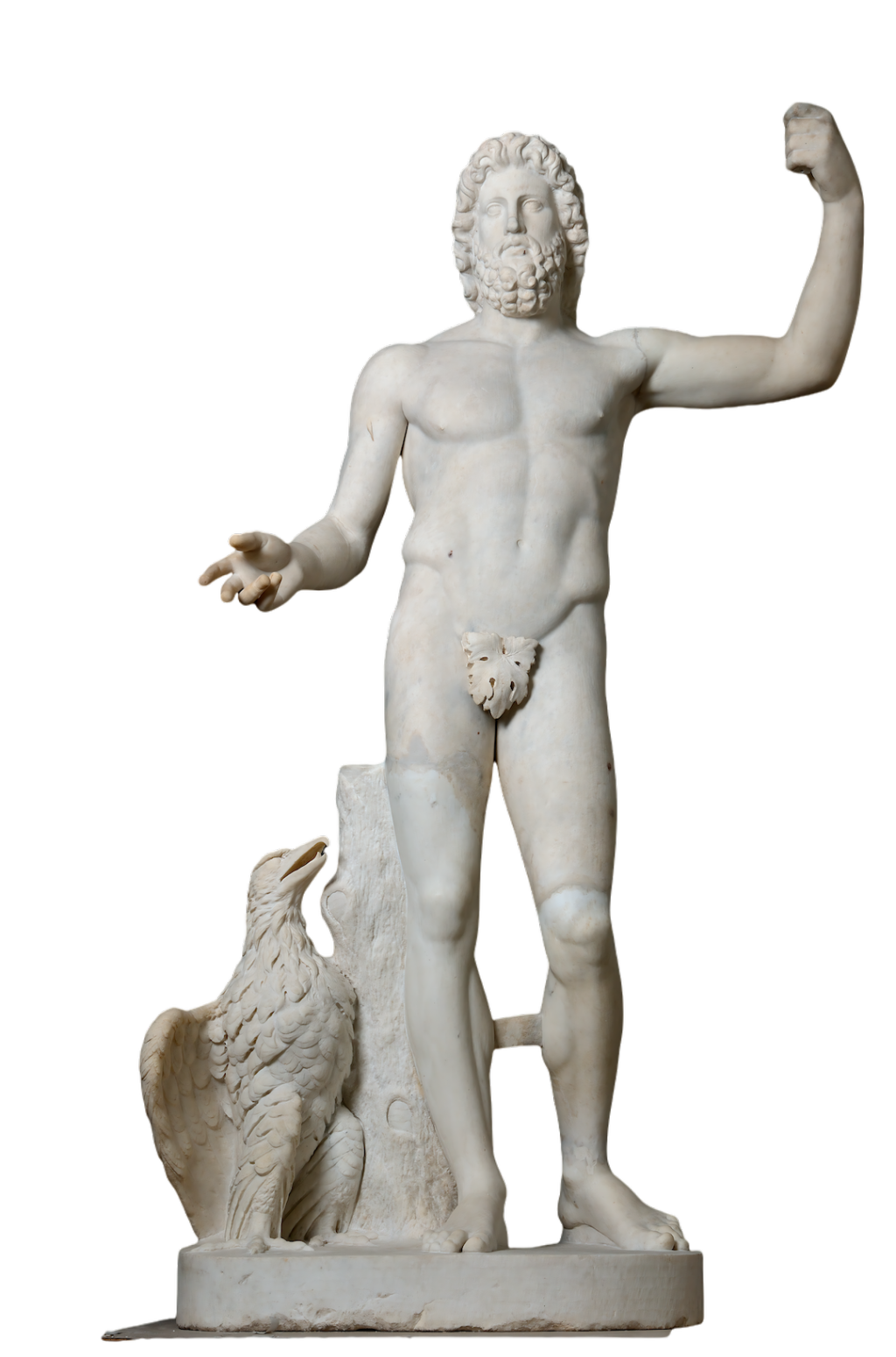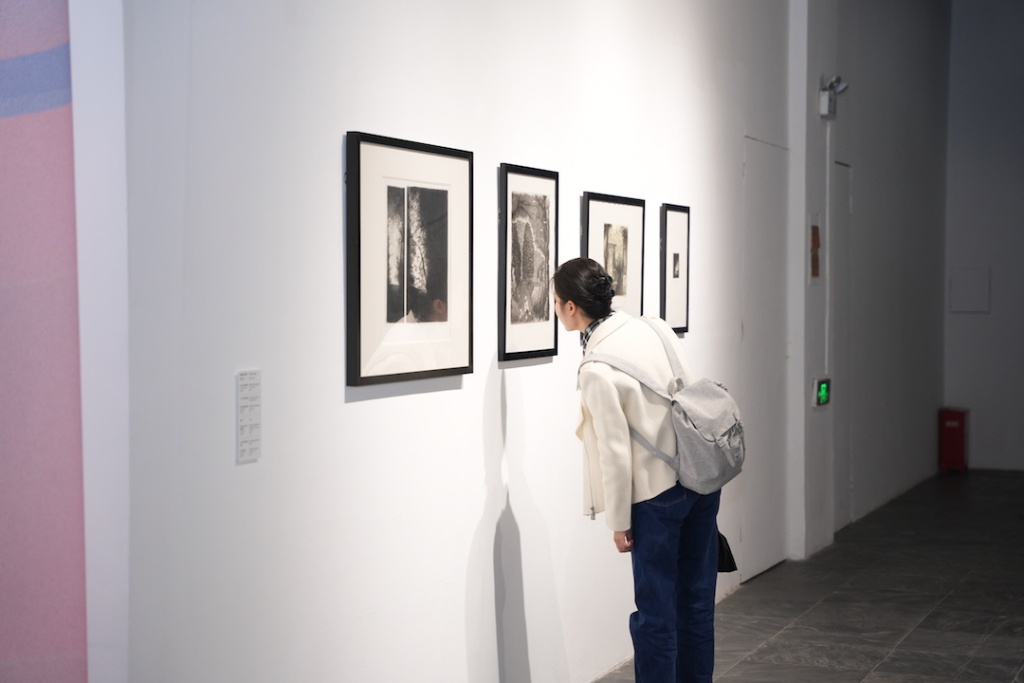
The Etruscan civilization is the first highly developed civilization on the Italian peninsula, and its age is roughly equivalent to the late Western Zhou Dynasty in my country, the Spring and Autumn and Warring States Periods to the Qin Dynasty. The Etruscan civilization influenced the religion, culture, and political form of Rome, and even had a profound impact on later Western civilization.
The Paper learned that on August 29, the special exhibition "Etruscans - Aristocrats of Ancient Italy", co-hosted by the Wu Culture Museum and the Bologna Municipal Archaeological Museum and exhibited by the Naples National Archaeological Museum, opened at the Suzhou Wu Culture Museum. The exhibition brings together a total of 332 pieces (sets) of cultural relics related to the Etruscan civilization. The exhibition is divided into five parts. The exhibits include a wide variety of daily necessities, exquisite decorations, statues, etc., highlighting the millennium rise and fall of the Etruscan civilization from the flourishing to the complete naturalization of Rome from different aspects. It is reported that the exhibition will last until November 30.
The Paper had a dialogue with curator Federica Guidi on the spot. 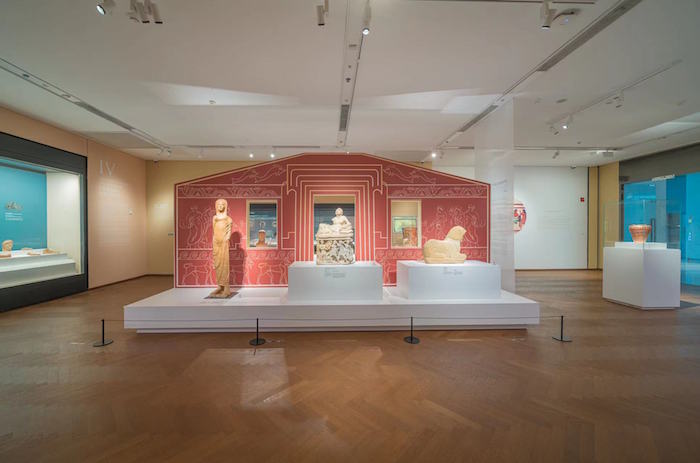
exhibition site
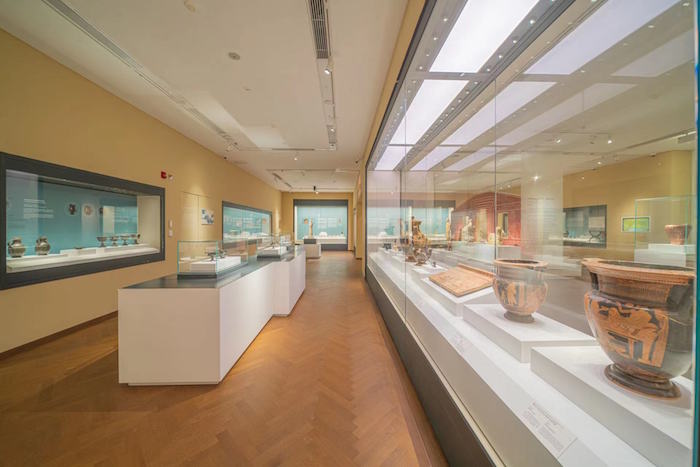
exhibition site
Etruscan civilization in pre-Roman times
Ancient Italy has witnessed the ups and downs of many cultures. Ethnic groups such as Liguria, Umbria, Samone, and Etruscan complement each other, and other ethnic groups such as Greeks and Phoenicians also came to Italy through colonization or invasion. It can be said that in pre-Roman Italy, ethnic groups were diverse and complex. Different peoples also had different histories, development methods, and political and social structures, but in the end, they came to the same end, that is, they were incorporated into the territory of Rome.
The Etruscans played an important role in many ways in this history. According to historical sources, in pre-Roman times (between the 10th and 3rd centuries BC), the Etruscans "occupied almost the whole of Italy, with a reputation from the Alps to the Straits of Sicily".
The Etruscans are a free and romantic nation. They are the builders of Italian cities, as well as the creators of exquisite ornaments and statues. Their civilization has influenced the religion and culture of Rome, and even has a bearing on the Western civilization of later generations. deep influence. 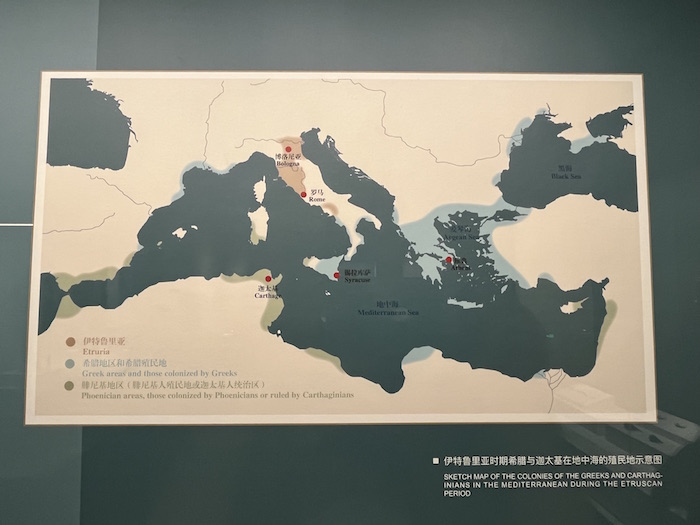
Schematic diagram of the Etruscan period and Carthaginian colonies in the Mediterranean
Around the eleventh century BC, the earliest Etruscans appeared between the Tiber and Arno rivers in central Italy. They are smart and optimistic, good at opening fields for irrigation and drainage, building bridges and roads, good at farming, good at sea trade, good at mining and smelting, and good at building and managing cities. Their culture soon prospered there and the economy took off by leaps and bounds.
From the eighth century BC to the seventh century BC, the Etruscans developed from several small tribes into walled city-states with concentrated populations. and rapid economic rise.
By the 6th century BC, the Etruscan territory in its heyday spanned the entire region of the Apennine Mountains to the north. The Tarquins, who ruled Etruscans, built gigantic buildings and paved squares there. At this time, a large public place for the worship of the gods, the sanctuary, appeared. Cities concentrate economic resources, culture, and ideas in sanctuaries, shaping them into highly representative places in the community. During the same period, with the popularization of Tuscan temples, temple architecture was also endowed with extraordinary significance. 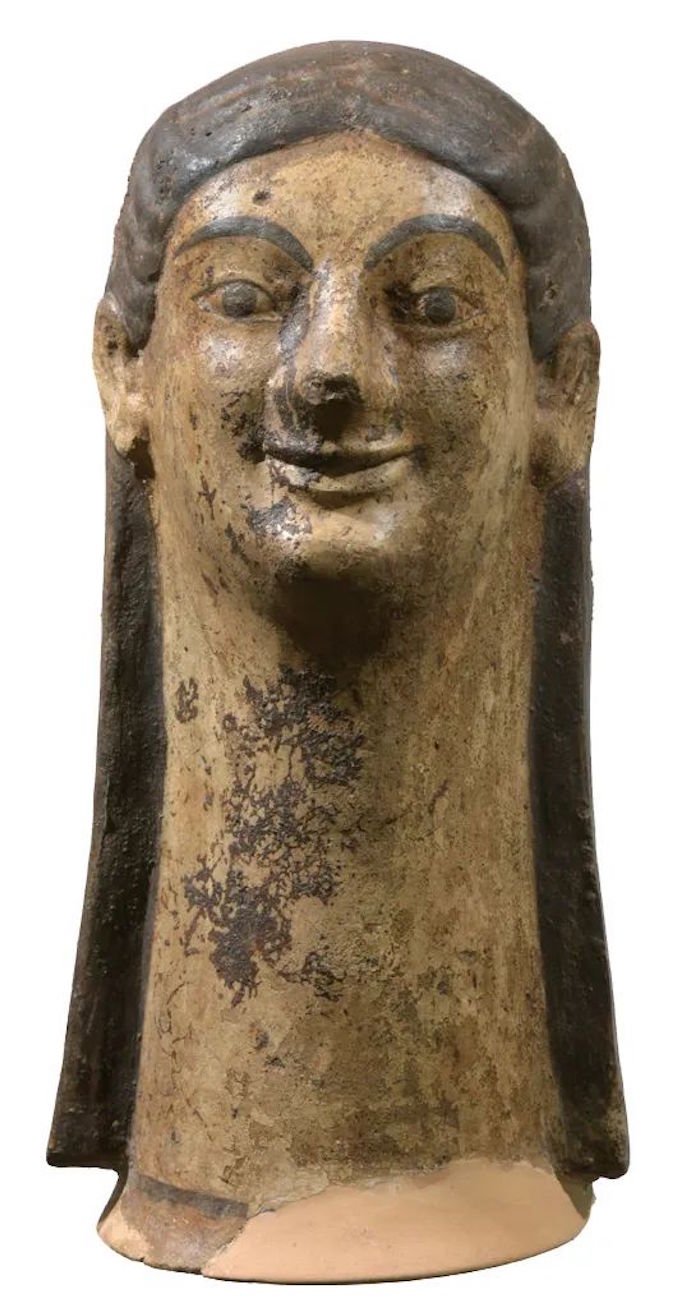
Etruscans: Sphinx head pediment, pottery, mid-6th century BC, National Archaeological Museum, Naples
Caption: Since the 6th century BC, public monuments such as temples and sanctuaries have appeared in Etruscan cities. This ceramic statue is the top ornament of the temple, probably a triangular gable ornament. This statue depicts the head of the Sphinx. A sphinx is a mythological creature with a sphinx, often with wings.

Installation view of "Etruscans - Nobility of Ancient Italy"
The Etruscan cultural relics that have survived to this day show us all aspects of people's lives at that time, including the social roles of both genders, as well as their clothing accessories, daily activities, banquet customs and utensils, the development of writing and religious beliefs.
How should Chinese audiences watch and interpret this distant ancient civilization? On the occasion of the opening of the exhibition, The Paper interviewed archaeologist and exhibition curator Federica Guidi. 
Curator Federica Guidi
Dialogue | Curator Federica Guidy
The Paper: Could you please talk about the stage and status of the "Etruscan civilization" in the history of ancient Italy?
Federica: The Etruscan civilization occupied an important position in ancient Italy, and they were one of the most important peoples in ancient Italy at that time. The Etruscans extended their entire sphere of influence throughout central Italy between the 9th century BC and the Roman conquest of all of Italy. And such a large territory also has a very diverse geographical environment, which affects their development.
In the early stages, they were not only rooted in the interior, but also looked out to the ocean. They are dedicated to the development of agriculture, especially developing special skills in water management. In addition, they are unique in mining mineral resources. At the same time, the Etruscans had a very important position in the Mediterranean regional trade line, and also had a pivotal position in the Italian peninsula before Rome.
At that time the main Etruscan settlements consisted of several regions, with their own city-states. Among them, the center of the north is today's Bologna. The Etruscan civilization has a very important history in these cities, so in ancient Italy, the Etruscans were the earliest city builders. According to Latin sources, almost the whole of Italy was under Etruscan rule. 
The Apulians: Human-faced Crete dishes, pottery, 340 BC | 320, Municipal Archaeological Museum of Bologna
Caption: From the first half of the 8th century BC, southern Italy began to be influenced by Greek culture. Soon after the middle of the 5th century BC, some centers of Greater Greece developed a red-painted pottery imitating that of Athens.
The Paper: What characteristics do the Etruscans have in culture, life, and belief? It is said that cremation is its unique cultural belief?
Federica: The Etruscan civilization was developing in many parts of Italy at that time. Compared to the Greeks and Romans of their time, the Etruscans were a wealthy, proud people who enjoyed their extravagant lives.
Deeply rooted in their territories, they are also committed to foreign exchange and cultural communication, especially with the Near East and Greece. In the early days, such exchanges started with wealthy nobles, and then trade became more and more intensive. The Etruscans had very professional artists, and their temples had terracotta decorations, which is reflected in the exhibition. In addition, they are very skilled at processing gold, such as gold microbeading, which presents very small gold balls on the surface of jewelry.
In Etruscan society, it is the position of women that is more peculiar. At the time, Etruscan women played a very important role in household management, unlike the Greeks and Latins of the time. At the same time, women can participate in public life like men, and women can participate in banquets and sports activities like men. Etruscan women were also able to hold their own property and keep their names after marriage. 
Gorgon figurine, pottery, early 6th century BC, height 37 cm, width 38 cm, National Archaeological Museum, Naples
Caption: Gorgons are mythical creatures. She has a female face and a venomous snake head, and her ferocious face with open mouth and tongue is terrifying. Legend has it that anyone who sees her will turn to stone. The image of the Gorgon is believed to have the power to ward off and exorcise evil spirits, and it is often used in building decorations.
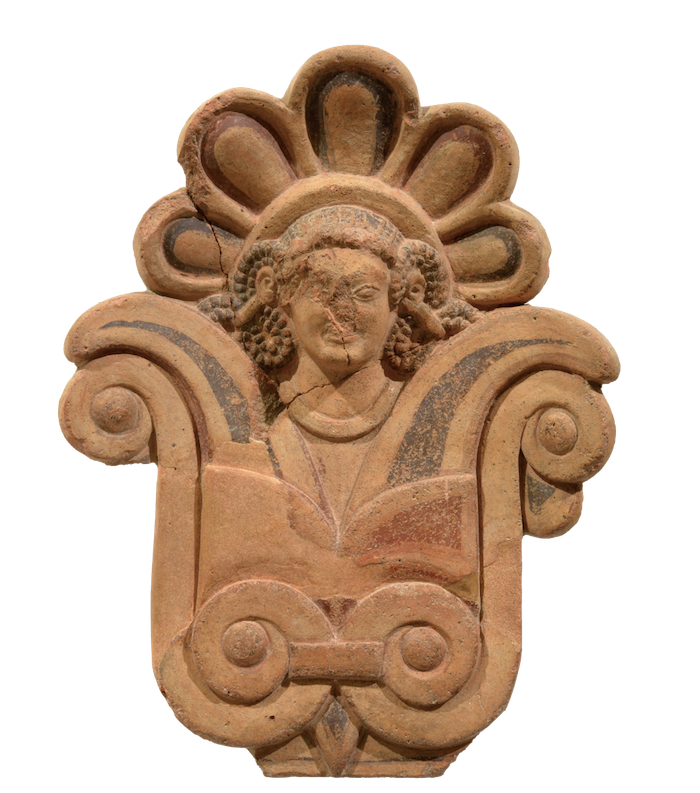
Feminine head with enamel, pottery, early 6th century BC, National Archaeological Museum, Naples
Caption: This tile eaves ornament shows the face of a woman with jet-black hair tangled behind her ears, emerging from a lotus flower. The lotus pattern was introduced from the eastern Mediterranean and was used by the Etruscans as a decorative pattern and as a symbol of purity. The head of the girl is surrounded by a petal decoration (halo), reminiscent of a seashell pattern.
From an artistic and cultural point of view, Etruscan culture is very open, they accept ideas from other peoples, and also create some Etruscan religious life. Their priests, also called "divers", were able to read the will of the gods. In the concept of "afterlife", the Etruscans believed that after death, the deceased can retain their identity and continue to enjoy eternal life. At least in certain periods of Etruscan history, they had this idea.
According to the oldest Etruscan funerary beliefs, the dead do not stay in the tomb after death, as the tomb is only the first stop on their long undead journey. In the 5th century BC, the Etruscans were influenced by Greek culture in their belief in the afterlife, which was mainly manifested in the reception at the funeral. These banquet scenes are exquisitely depicted on the unearthed tomb murals, and these banquets represent the final state of the deceased who have overcome all difficulties and solved all problems on the journey of the dead. 
Funerary objects in a cremation tomb, pottery and bronze, late 9th century BC, early 8th century BC, Tomb 292, San Vitale Cemetery, Municipal Archaeological Museum of Bologna
Caption: Cremation tomb, originally surrounded by stone slabs. After cremation, the ashes of the deceased are collected and placed in urns. The urn was covered with a clay bowl that served as a lid. The funeral objects are very simple, only a bronze needle. This ornament was used to fasten the cloak worn by men, so the owner of the tomb was a man.

House-shaped urn, pottery, late 9th century BC - 8th century BC, Vituronia (Grosseto), Municipal Archaeological Museum of Bologna
Caption: These house-shaped urns belonged to prominent figures, indicating their status as the head of their family. The practice of placing ashes in house-shaped urns was widespread, especially in southern Etruria and Lazio, from the Bronze Age to the Iron Age. The shape also showcases one of the oldest forms of housing, the thatched hut, which is characterized by an oval building and a structure of wooden beams covered with thatch, sometimes decorated with symbolic sculptures that symbolize the protection of the house and its inhabitants.
In the Etruscan civilization, there are two main forms of burial, one is burial and the other is cremation. At present, it is difficult to precisely decipher which of these two forms have the exact meaning. In general, cremation may be related to the evolution of fire and the role of sacrifice, representing the authority of the nobility, and also reflecting the funerals of heroes in ancient Greek epics at that time. In burials, the deceased are usually surrounded by grave goods, including their own personal belongings, as well as things that reflect their status. Nearly all Etruscan burials contain burial objects, the composition of which has changed over time, as well as with people's ideas about the afterlife. In the early days, the funerary objects were very simple, but in the later period, the funerary objects were gradually enriched. For example, in the exhibition hall, the cultural relics unearthed from the tombs of the 5th century BC, some of which were banquet utensils, symbolizing their desire to continue to enjoy after death. 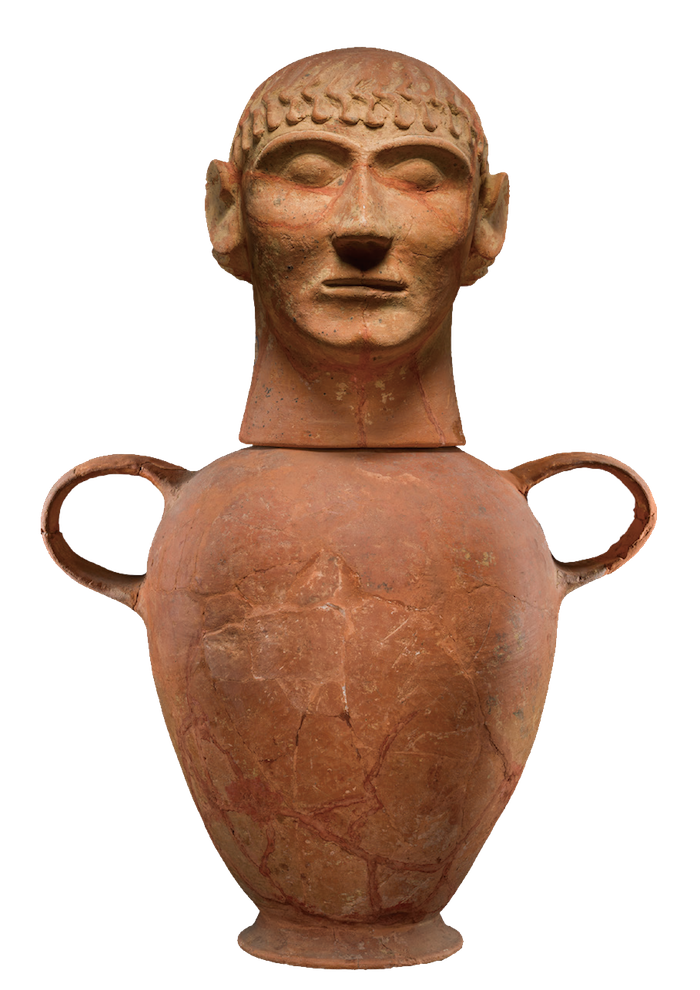
Canopic jar with lid, pottery, late 7th century BC, early 6th century BC, Municipal Archaeological Museum of Bologna
Caption: Human-shaped urns are often found in high-level burials from the 7th to early 6th centuries BC to "recover" the cremated bodies of the deceased. The production of this exhibit uses the most advanced methods. Although the shape of the head adopts a realistic style, it is not an accurate reflection of the appearance of the deceased, but a freehand representation.

Woman's Votive Statue, Bronze, circa 480 BC, Municipal Archaeological Museum of Bologna
Caption: This statue is the image of a woman offering offerings to the gods. It was a custom in the Etruscan region to make bronze statues of animals, believers or gods dedicated to the gods, to thank the gods for their grace or to ask for their blessings. Dressed in a corseted tunic, a wide cloak over her shoulders, her hair tied with a narrow ribbon, the woman holds flowers and pomegranates symbolizing fertility, and is decorated with delicate geometric patterns.
The Paper: What are the artistic characteristics of "Etruscan civilization"? What are the similarities and differences between Greece and Rome? Can you explain it with an example of an exhibit?
Federica: From the 8th century BC, there was a lot of communication between the Etruscans and the Greeks, and these exchanges were reflected on different levels, including the Etruscans selling the Greeks metal, the Greeks People sold to Etruscans pottery etc. In addition to Greece, the peoples of the Eastern Mediterranean at that time also had a profound influence on Etruscan culture and art. In the process, the Etruscans also produced new ways of thinking, new cultures, new arts and new religions. They took these elements and incorporated them into local traditions. Many of their fusions were later inherited by Rome.
At that time Etruscan society was ruled by large noble families. These nobles imported items from the Middle East that symbolized royal power, such as thrones and scepters. At the same time, they began to value horses and chariots, because they recognized that chariots and horses were also symbols of power and wealth. On the utensils, they introduced perfumes, balms and related containers. 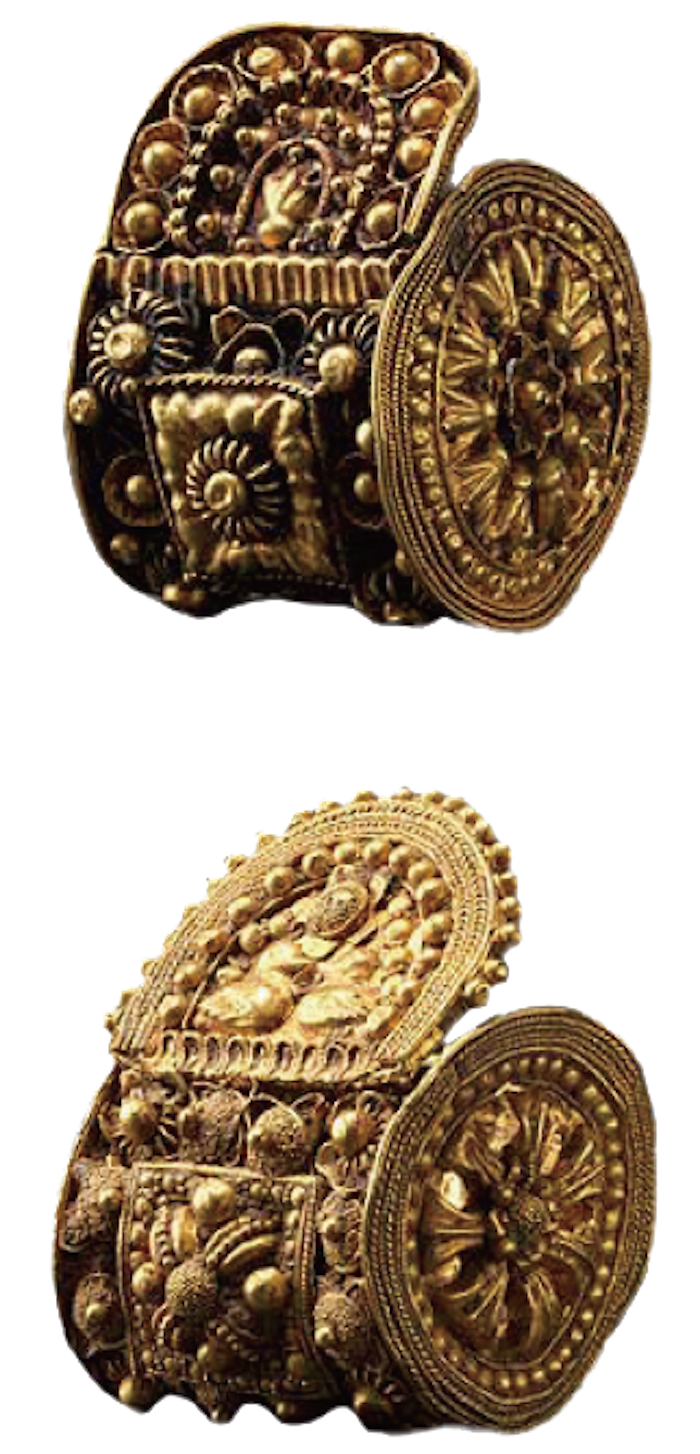
Box earrings, pottery, second half of the 6th century BC, National Archaeological Museum, Naples
Caption: Box earrings are typical jewelry in Etruria (especially southern Etruria) from the 6th to the 5th century BC. The wearers are mainly noble women. The rich decoration reproduces non-realistic botanical motifs such as palms, leaves, flowers and roses.
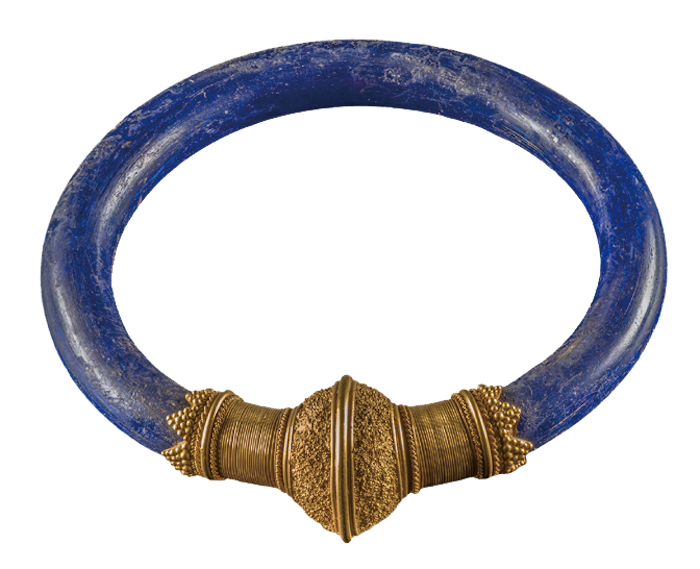
Blue glass bracelet with gold clasp, glass, gold, late 6th century BC - early 5th century BC, Municipal Archaeological Museum of Bologna
Caption: The bracelet is made of glass and fastened with a gold ball clasp, which should be an accessory for wealthy women. The clasp is decorated with a delicate gold thread pattern and small gold beads.

Crouching fawn-shaped balm jar, pottery, mid-6th century BC, National Archaeological Museum, Naples
Caption: Etruscans who love life and attach great importance to personal care. Razors, tweezers, expensive perfume containers and mirrors have been found in lavish Etruscan tombs. Of particular interest are the assorted balm bottles. This unique balm jar resembles a crouching fawn with its limbs tucked under its body. The fur is presented in small brown dots. The head is removable and acts as a stopper to seal the jar.
Culturally, the Etruscans learned the alphabet and writing from Greece. The Greek alphabet had been assimilated by the Etruscans in the 8th century BC and adapted to their own language according to their own needs, who then spread the alphabet to other peoples in ancient Italy, including later Roman.
In addition, they learned from Greece the customs of banquets. Later, banquets became a very important part of Etruscan social life. Their drinking ceremony is only drinking, but at the banquet, they drink and eat meat, and there is music and dancing to add to the fun. Participants also played some board games. Such banquets were an important moment in society for the living, and later became an important ritual in funerals.
In the three civilizations of Greece, Rome, and Etruscans, they used similar methods to shape the gods, creating a common image of the gods among the three civilizations. 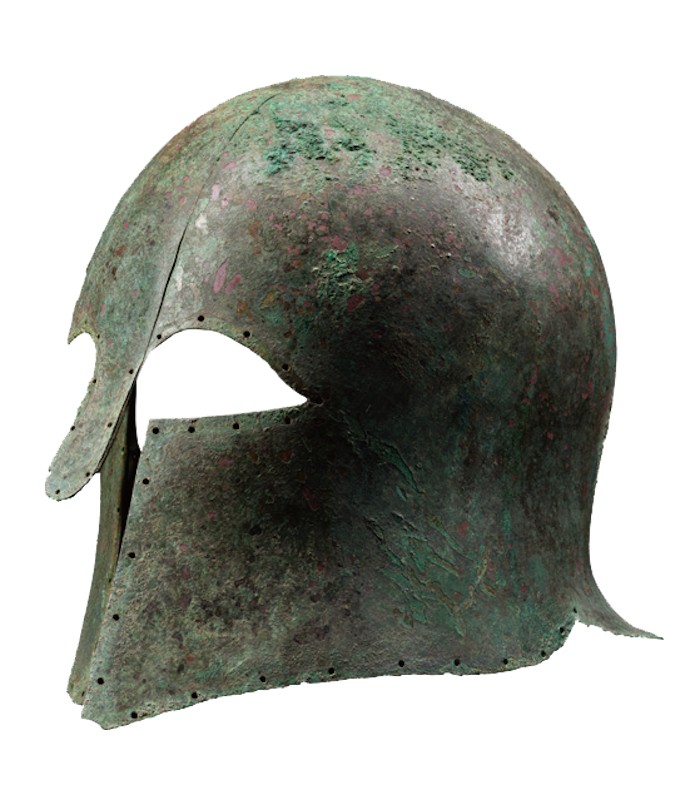
Corinthian helmet, bronze, late 7th century BC - 6th century BC, Municipal Archaeological Museum of Bologna
Caption: The power of Etruscan men is mainly reflected in: fully armed, defending their family and property, so weapons, horses, chariots, scepters and other symbols of force, wealth and social status are often found in male tombs . The Corinthian helmet covers the face and neck almost completely, leaving only slits at the eyes and mouth. The helmet takes its name from the Greek city of Corinth, where it originated, and from which it spread to Italy.
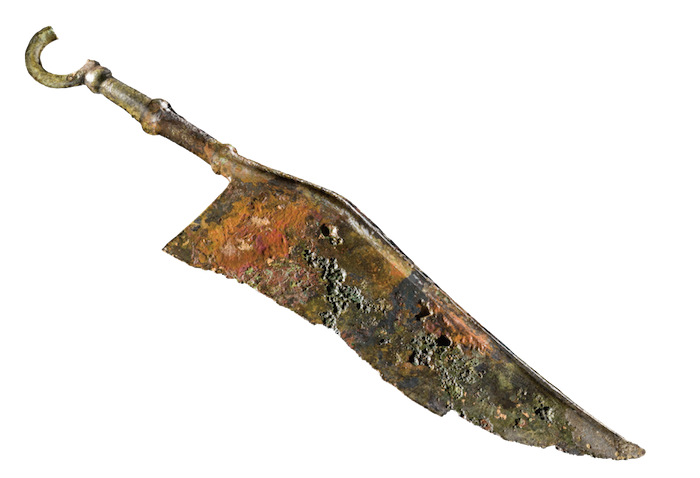
Weaver knife, bronze, late 8th century BC-early 7th century AD, Municipal Archaeological Museum of Bologna
Caption: Women are an important support for the Etruscan family. In addition to taking care of the family and raising offspring, they also undertake the important task of weaving. The weaving knife was a tool used by Etruscan noble women to cut silk threads when they were weaving, and sometimes appeared together with other textile tools used to make and process silk threads.
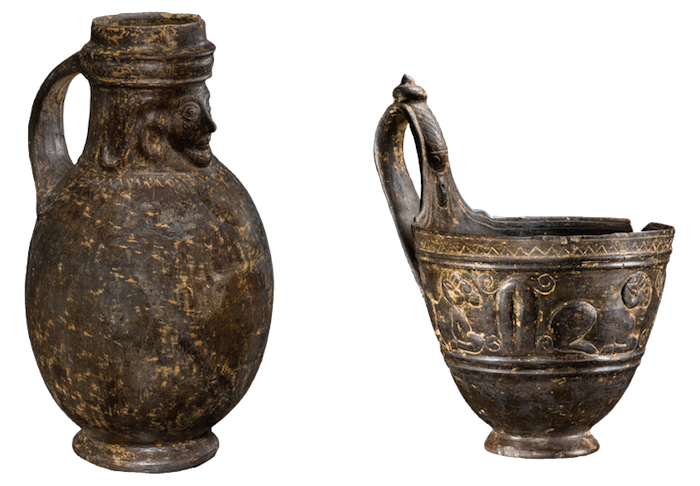
Banquet utensils, Bucqueiro, mid-6th century BC, Municipal Archaeological Museum of Bologna
Caption: This group of heavy Buqueiro utensils is typical of Chiusi and Orvieto, where workshops specialize in thick-walled utensils decorated with intricate and luxurious reliefs. There were about 100 utensils in the burial, including the Big Anfara lidded jar for wine, the Cassos scoop for wine, the jug for pouring wine, and wine glasses of various shapes.
The Paper: The exhibition introduction said, "It (Etruscan civilization) influenced the religion, culture, and political form of Rome, and even had a profound impact on later Western civilization." Can you talk about this?
Federica: Roman society learned from the Etruscans religions, rituals, such as deciphering the will of the gods through natural phenomena, so the ancient soothsayers also spread from the Etruscan civilization to the Roman world. At the same time, the Romans learned from the Etruscans the techniques of building and decorating temples. The Temple of Jupiter was actually built in the form of an Etruscan temple. In addition, there is the alphabet just mentioned. Of course, early Rome was actually under the rule of the Etruscans. 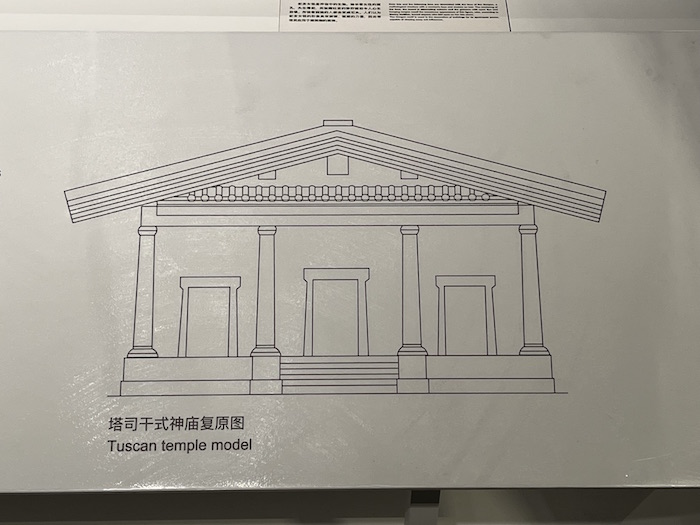
Exhibition hall scene, temple restoration map
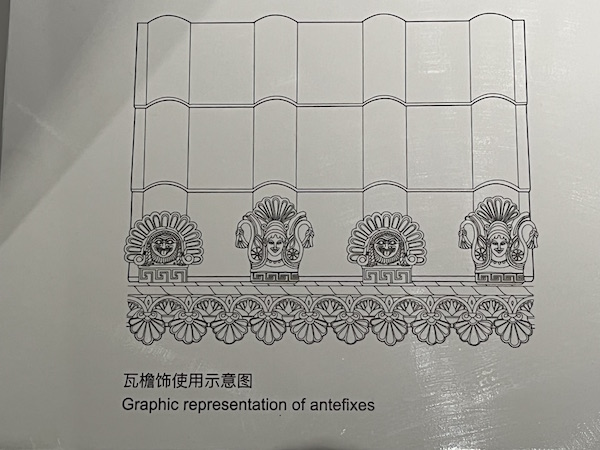
The scene of the exhibition hall, the schematic diagram of the tile eaves of the Etruscan temple
The early Romans learned some funerary customs from the Etruscans and made some assimilation. Among them, the most famous is the Etruscan funerary sports competition, which later developed into the Roman gladiator competition.
During the Renaissance in the 15th century, Italians were very proud to have such an ancient civilization and claimed to be the heirs of this civilization. At the time, cities were very proud of their local relics of Etruscan civilization, and archaeological discoveries were seen as a return to a lost civilization. Italian aristocrats at that time claimed to have Etruscan traditions. For example, Quasimo of the Medici family claimed to be the inheritor of Etruscan culture. The artist Leonardo da Vinci also drew inspiration from Etruscan artifacts.
Based on this, we can understand that Etruscan culture did not disappear overnight, but integrated into Roman society, and has continued to the present modern society.
The Paper: Which exhibits do you recommend the audience to watch the most? What is the reason?
Federica: In the gallery, two small bronze statues clearly reflect the connection between Etruscan and Greek art. Both statues depict Etruscans, but their figures bear traces of Greek sculpture art. 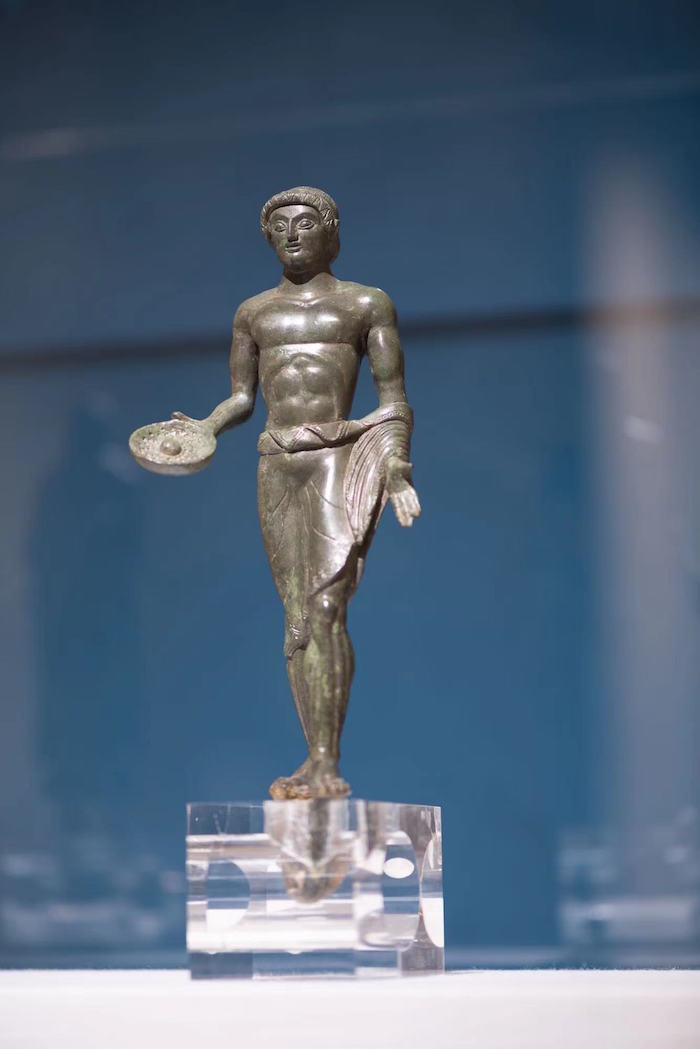
Exhibition site, bronze statue
In the second unit, the colorful earthen eaves are similar to the Chinese tiledang. And those bronze, silver, gold, amber ornaments reflect the superb craftsmanship of the Etruscans. Of course, there are also Greek wine vessels, purchased from the Greeks by the Etruscans, which depict rich banquet scenes. Legends about ancient gods can be seen on these wine vessels, as well as sports competitions, images of men and women at banquets, etc. These decorations are like a thick comic book, reflecting the lives of people at that time. 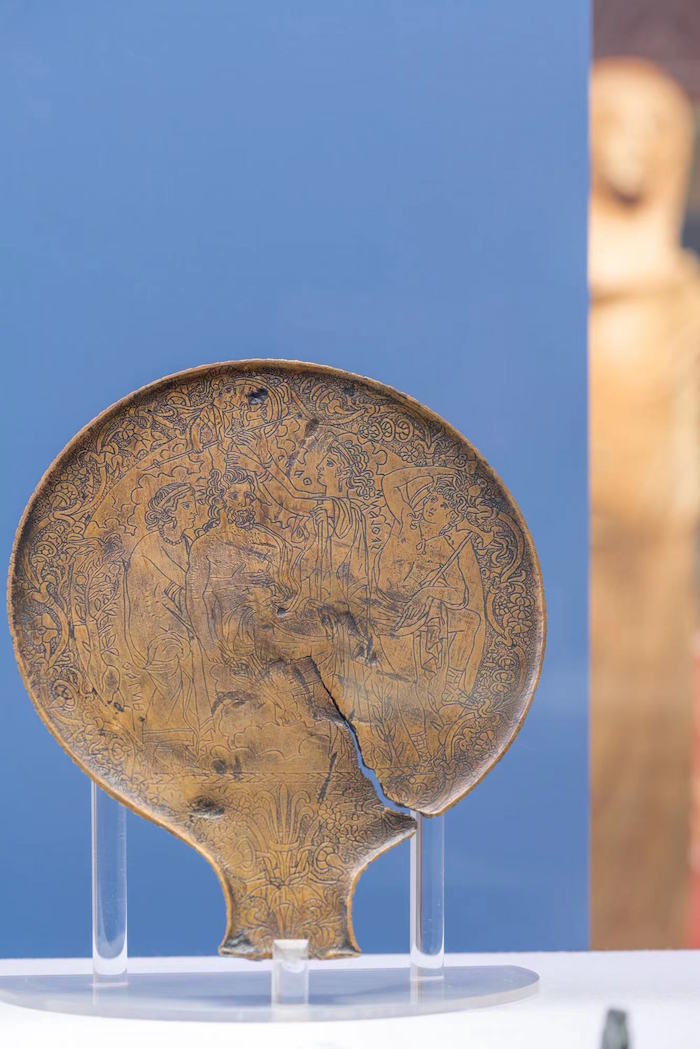
exhibition site
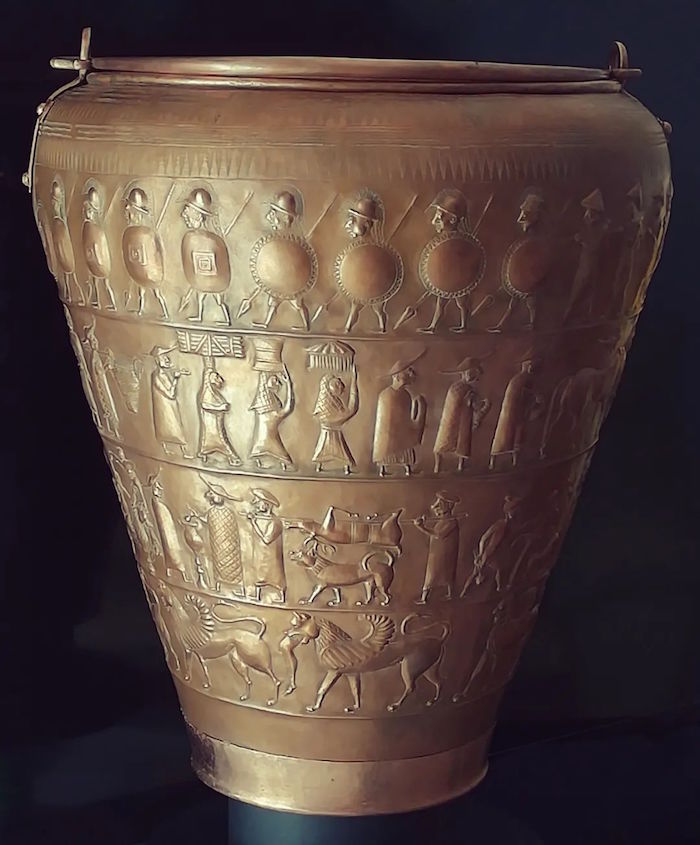
Cedosa Citula Barrel (replica), bronze, original: first half of the 6th century BC; reproduction: 20th century, Cedoza Cemetery, Tomb 68, original preserved in the Municipal Archaeological Museum of Bologna, St. Replica by Vano Busson
A cedoza citura barrel (replica) is a frustoconical container usually used to hold liquids such as water, milk, or wine. The decorative content on the object is also a summary of the exhibition, as it includes male and female activities, including the Etruscan sports, including feasts, and their sacrifices to the gods. The stories unfolding on the surface of this vessel are the richest and most detailed in the entire ancient Western society.
Chinese audiences are very far away from Etruscan civilization in terms of time and region. I hope this exhibition can help Chinese audiences understand this ancient civilization. We hope that everyone will discover the differences and similarities between Chinese and Western civilizations. For Chinese audiences, this is not only to understand the ancient Western civilization, but also to have a deeper understanding of their own civilization.
